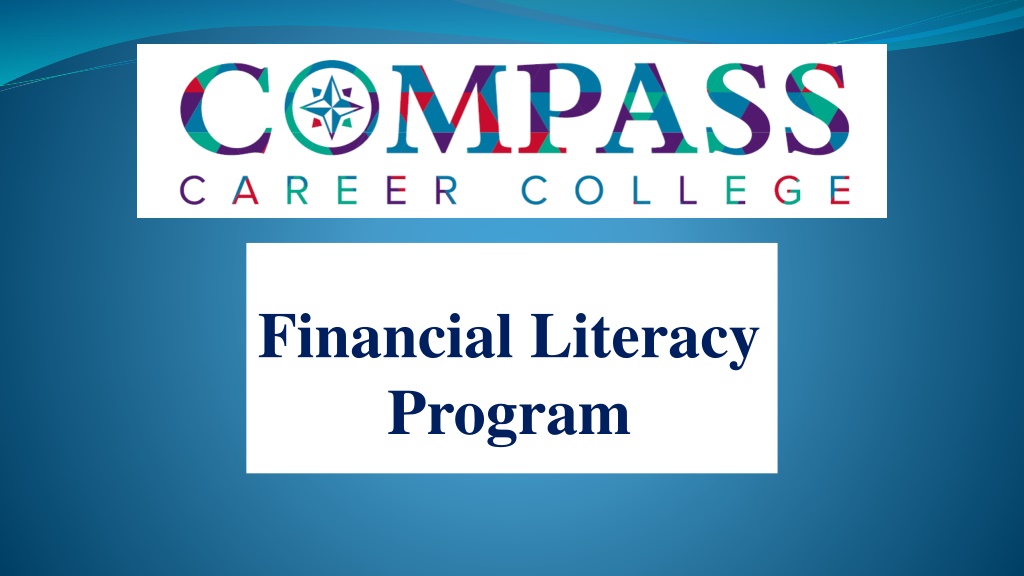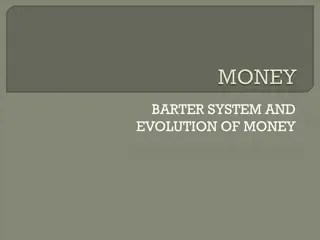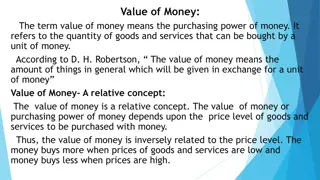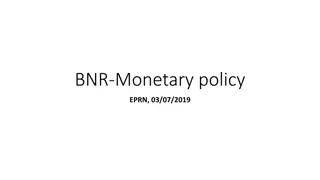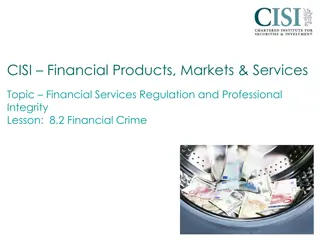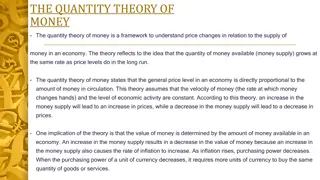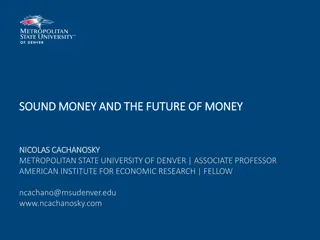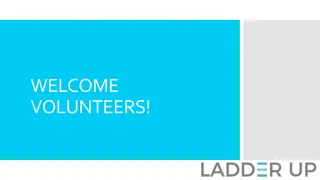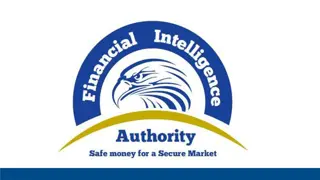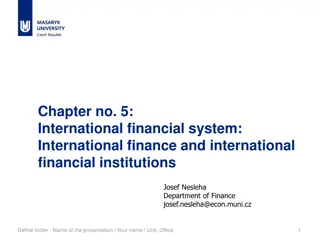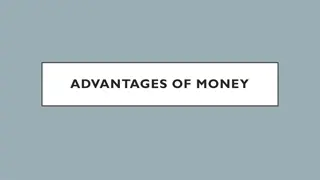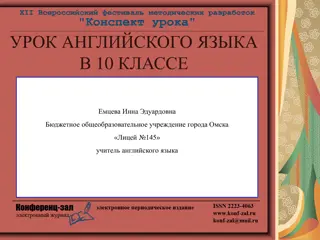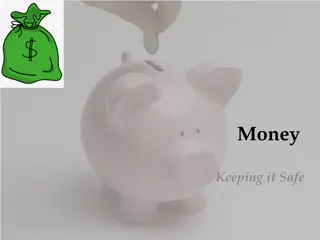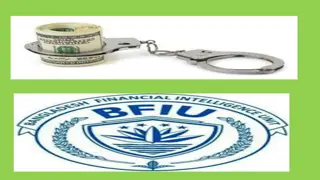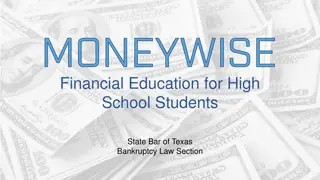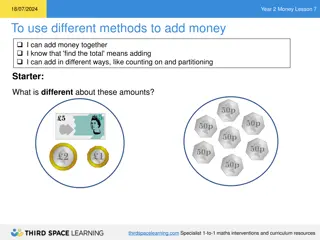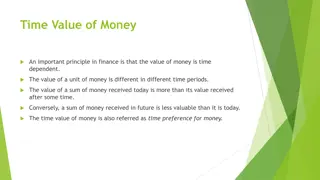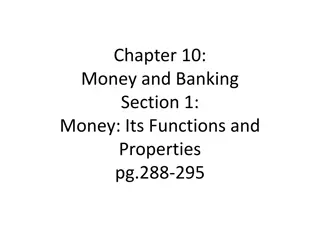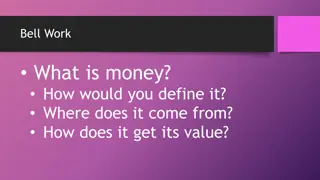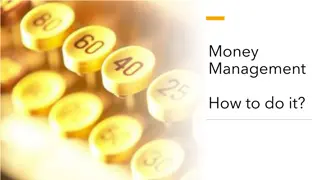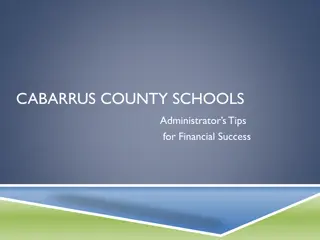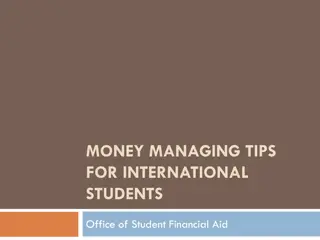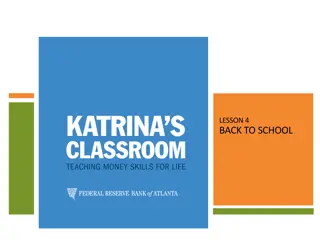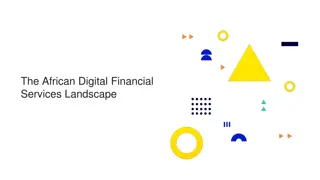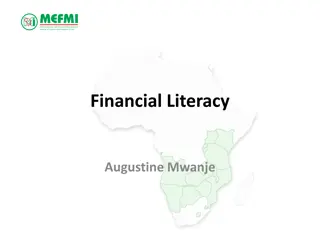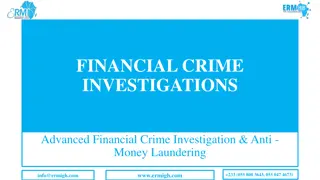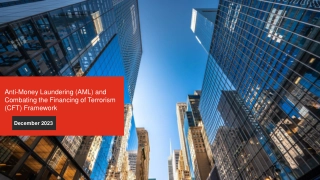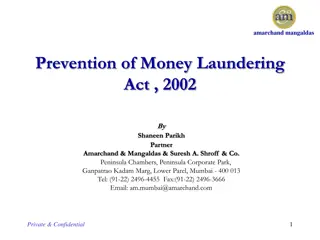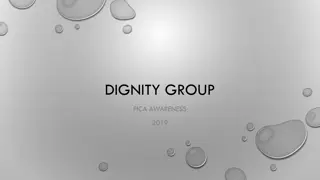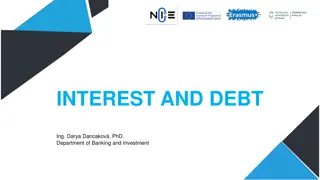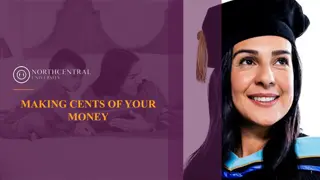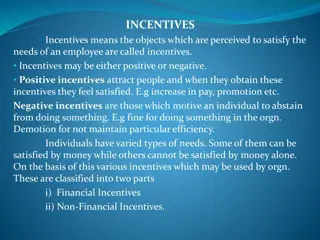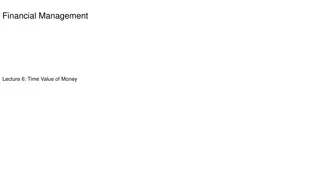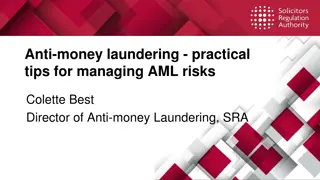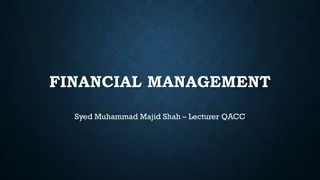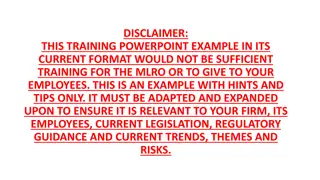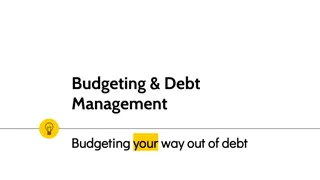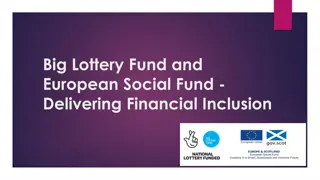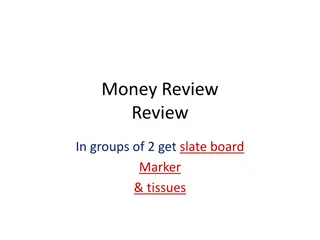Effective Money Management Tips for Financial Success
Learn essential financial literacy tips including budgeting strategies, the importance of saving, tracking spending habits, distinguishing needs from wants, and setting financial goals. Discover how small changes in your daily habits can lead to significant long-term financial benefits.
Download Presentation

Please find below an Image/Link to download the presentation.
The content on the website is provided AS IS for your information and personal use only. It may not be sold, licensed, or shared on other websites without obtaining consent from the author. Download presentation by click this link. If you encounter any issues during the download, it is possible that the publisher has removed the file from their server.
E N D
Presentation Transcript
Financial Literacy Program
Budgeting: It Pays to Plan There are many negative connotations around the term Budget Many people assume that a budget is about deprivation The main goal of a budget is to spend less than you earn The small stuff is what breaks most people s budgets because they are not aware of small dollar amounts being spent here and there
Budgeting: It Pays to Plan Financial experts recommend that you pay yourself first by saving It is recommended that you save 20% of your income The more you save at a young age, the longer you have for your investments to work in your favor At a 5% interest rate, if you save just $600 per year starting at age 20 you would accumulate more than $77,000 in interest by the time you reach age 65
Money Management: Break the Spending Habit Keep a Spending Journal for one month to determine your spending habits Write down everything you purchase and keep your receipts Don t forget to include the small stuff. Small stuff adds up quickly For example, a large fancy coffee drink such as a latte costs around $4.25 a day and well over $1,000 if purchased five days a week for a year. By cutting the latte habit to Mondays and Fridays, you ll save over $500 per year
Money Management: Break the Spending Habit Needs Versus Wants The things we really need in life are limited and include food, shelter, relationships, and clothing Students may want to add tuition and fees, and books and supplies Needs can be satisfied very simply or extravagantly If you can downgrade your standard of living you may be able to graduate with significantly less debt Mark the items on your spending journal as a want or need It s okay to buy an occasional want but when you are trying to live on a budget, wants may be the cause of the biggest leaks in your spending plan
Money Management: Break the Spending Habit Set Goals Setting goals and saving diligently for them is the driver of your budget I m not going to buy a latte today so that I can afford to go somewhere warm for spring break next year Short-term Goals: 6-24 months These are goals that you ll save actively for in order to meet deadlines like car maintenance or next semester s tuition Mid-range Goals: 2-5 years These goals may be bigger picture items like paying down debt or saving a down payment for a house Long-term Goals: 5+ years These are the big things such as retiring early or paying for a child s college education
Banking: Stay In Balance Checking accounts are important for paying month to month expenses Some banks waive monthly fees for students Many banks will also give discounts for electronic banking Questions to ask when opening a checking account Is there a minimum balance required? What if I fall beneath the minimum balance? What kind of fees does the bank charge? Is there a limit to the number of checks I can write monthly? Does the account offer overdraft protection?
Banking: Preventing Overdrafts Overdrafts are expensive There are lots of fees you ll be charged if you do not keep a positive balance in your checking account. For example: Freddy s Pizza check = $15.86 Non-sufficient Funds (NSF) fee = $25.00 Pizza parlor charge for NSF check = $25.00 Total cost of pizza = $65.86 Ways to prevent an overdraft Overdraft Protection Be sure to record your checks, debits and automatic drafts in your check register, and balance your checkbook often
Banking: Balancing Your Checkbook Tips to keep your checkbook in the black: Try to keep a cushion of at least $500 in your account Write down any debits in your check register Checks Debit card purchases Automatic debits Bank fees Don t believe the balance the ATM says you have It does not take into account checks or debits which have not cleared yet Avoid ATMs that charge transaction fees Balance your checkbook on a monthly basis
Banking: Debit Cards Most checking accounts come with a debit card Debit cards often look like a credit card including a Visa or Master Card logo Using a debit card is like writing a check Don t forget to record all of your debit card purchases Using a debit card to withdraw cash from an ATM can also be expensive ATM fees can be as much as $2.00 per transaction Some retailers such as gas stations, car rental agencies and hotels will place a $100 hold on your checking account until whatever you purchased clears While the account is on hold, this money is unavailable to cover other purchases
Credit: Know the Score When you take out a loan or use a credit card, you are building a credit history Whether you pay back your loan on time or are responsible with your credit card determines your credit rating Companies use your credit rating to make decisions about you Lenders Apartment managers Insurance agencies Employers
Credit: Know the Score Credit scores (FICO or BEACON scores) fall into the range of 350-850 If your score is above 720 you ll get the best rate on a loan Factors in your credit score: 35% Payment History 30% Amounts Owed 15% Length of Credit History 10% New Credit 10% Types of Credit Used
Credit: Know the Score Getting a better credit score: Pay bills on time Get current and stay current Contact your creditors for help Letting creditors know that you re having trouble may minimize damage Keep balances low on revolving accounts such as credit cards Pay off debt instead of moving it around Don t open a bunch of credit cards you don t need
Credit: Know the Score Each year you should request a copy of your credit report from all three major credit bureaus and make sure it is accurate www.annualcreditreport.com You can annually request a free credit report from all 3 major credit bureaus Credit Scores are available for a charge at any time Equifax: 800-685-1111 www.equifax.com Experian: 800-397-3742 www.experian.com TransUnion: 800-888-4213 www.transunion.com
Credit Cards: Take Charge 80% of undergraduate students have a credit card in their name with an average outstanding balance of over $2,100 Credit cards can be an easy way to build a good credit rating when used responsibly If you charge a small amount on your card each month and pay it in full (don t ever be late) you ll build a great rating by the time you finish school
Credit Cards: Take Charge A.P.R. (Annual Percentage Rate) is the rate of interest charged on your credit card Be careful that the rate stated is not a teaser rate Teaser Rates generally change after 3-6 months Most credit cards have a variable interest rate which can change at any time. Interest rates are likely to go up if you: Are late with your payments Go over your limit If you are late on your payments for another credit card
Credit Cards: Take Charge The Grace Period is the amount of time that you have to make a payment or pay off your balance before you are charged interest or finance charges Look for a card with a grace period of at least 20 days Fees Annual fee Transaction fees if you use your card at an ATM for a cash advance Overlimit fee Late fees
Credit Cards: Take Charge Credit cards can be expensive For example: If you have a beginning balance of $2,939 on a card with an APR of 19% and a credit limit of $3,000, and you are late with your payment Balance: $2,939 Interest: + 46 New Balance: $2,985 Late fee: + 35 New Balance: $3,020 Overlimit fee: + 35 New Balance: $3,055 Payment: - 120 New Balance: $2,935
Debt: Setting Priorities Pays Off Many students are stressed by the mountain of debt they have accrued while in school Many students report that they don t know how much debt they have. You ll have a hard time paying off your debt if you don t know how much you owe
Debt: Setting Priorities Pays Off Record each of your debts and set priorities for paying your debt Type of Loan Amount Owed Minimu m Payment Interest Rate Priority Credit Card $1,200 $100 16% 2 Student Loan $5,000 $50 6.8% 3 Collection Agency $500 $100 12% 1 At $100 per month, the Collection Agency debt is paid off in 5 months
Debt: Setting Priorities Pays Off Type of Loan Amount Owed Minimu m Payment Interest Rate Priority Credit Card $1,200 $100 16% 1 Student Loan $5,000 $50 6.8% 2 Collection Agency $500 $100 12% Paid As you pay off debts, simply move the minimum monthly payment of the paid debt to the next debt you want to pay off Making one payment amount and sticking to it retires the debt significantly faster than continuing on with a minimum monthly payment
Debt: Setting Priorities Pays Off Making minimum payments can be very costly If you make the minimum payment on a debt until it is paid off, your interest charges will be greater than the original amount charged
Identity Theft: Protect Your Financial Security Identity theft occurs when someone uses your personal information without your consent to commit fraud or other crimes People under the age of 25 are the number one targets of identity thieves Many people do not monitor their credit reports closely and thieves have an opportunity to exploit the situation
Identity Theft: Protect Your Financial Security People are victimized by two types of identity thieves Skilled professional thieves Acquaintances with access to your personal financial information
Identity Theft: Protect Your Financial Security Deter thieves from accessing your information by protecting it Guard your Social Security Number (SSN) Don t carry your card Don t write your SSN on a check When requested to give your SSN, ask how your information will be protected and if there is an alternative Shred documents with personal information with a cross-cut shredder before discarding Delete all unsolicited e-mails requesting personal information
Identity Theft: Protect Your Financial Security Use firewalls, anti-spyware and anti-virus software to protect your home computer Be smart when choosing a password Don t use an obvious password like your date of birth, mother s maiden name, or the last four digits of your SSN Keep personal information in a secure place at home Many victims report that roommates, family members and casual acquaintances access their personal information to commit identity theft
Identity Theft: Protect Your Financial Security Detect Identity Theft: Get a free copy of your credit reports annually Check credit card and bank statements carefully for accuracy Things to look for: Credit card and account statements with purchases you did not make Less or more mail than usual regarding your finances Unexpected denials of credit applications Unexpected increases in insurance rates Sudden calls from bill collectors
Identity Theft: Protect Your Financial Security Defend yourself Fast action on suspected identity theft is vital. Don t wait if you think you ve been victimized: Place a Fraud Alert on your credit reports Close any accounts that have been tampered with or that have been established fraudulently and ask for verification that the disputed accounts have been closed File a police report Use the ID Theft Affidavit from www.ftc.gov/idtheft to send to fraud divisions of police departments Report the theft to the Federal Trade Commission at 1-877-ID-THEFT (438-4338) Keep copies of documents and records of your conversations about the theft
